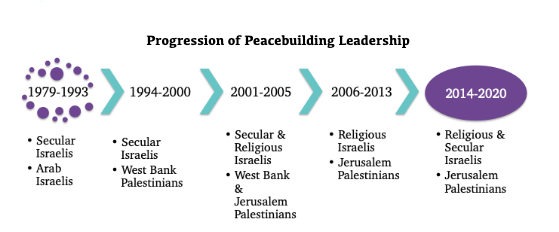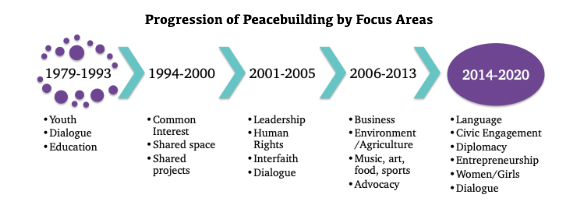By Laura Brawley
Abstract
As the long dormant peace process approaches its fourth decade of stalemate and the war in Gaza continues to rack up casualties, opinions regarding the efficacy of bottom-up peace-building have become increasingly nihilistic. Oftentimes, grassroots peace-building is at best seen as an incremental step towards reconciliation, and at worst seen as the trope of “hummus coexistence,” or the proliferation of coexistence-based peace organizations during the optimistic era of Oslo. Western media has proliferated the idea that interpersonal peace-building is all but dead in the aftermath of October 7th. However, this viewpoint glosses over the perpetual cycle of violence that has defined life in the region since the failure of Oslo, and the evolution and perseverance of Oslo-era peace organizations despite the continued intractability of the conflict. History shows that reputable peace organizations have not only persisted in the midst of violent conflict, but have adjusted their programming to be the most effective considering the current political climate. There is no reason to think that October 7th was the death knell of grassroots diplomacy. Amal-Tikva, The Abraham Initiatives and Parents Circle Families Forum are examples of NGOs that will see a future in a post October 7th world, as adapting to violence and upheaval is baked into their organizational structures. The landscape of peace-building will be different after the attacks, but not obliterated.

Graph from Amal-Tikva April 2020 Needs Assessment, tracks the leadership demographics of peace-building organizations (The State of Cross-Border Peace-building Efforts 2020)
The Contact Hypothesis and Israel/Palestine
- The Contact Hypothesis: framework for peace-building in intergroup conflict
- The hypothesis: intergroup contact can help to reduce negative intergroup stereotypes and mutual prejudices if certain conditions are met
- The conditions: equal status of both groups in the contact situation, ongoing personal interaction between individuals from both groups, situations in which members of both groups work together toward a common goal and institutional support from authorities for norms that bolster equality (Maoz).
- Harder to apply to asymmetrical and prolonged conflicts, but some scholars have adapted its principles to the Arab/Israeli Conflict
- The four methods for contact peace-building in Israel Palestine: the coexistence model, the joint projects model, the confrontational model, and the narrative/storytelling model (Maoz).
- The Oslo Accords gave rise to a boom in peace building projects initiated at the grassroots level, many of which were contact-based.
Critiques of Grassroots Peace-building
- Many scholars say that it is hard to measure the tangible impact of grassroots peace-building
- Their argument: peace-building has become an industry in Israel/Palestine- a performative way to funnel money into the peace process without actually evaluating these organizations for success
- Grassroots organizations are held to the following standards: “1) To “scale up” positive outcomes above and beyond direct participants, in order to produce “ripple effects” and broader impact; 2) To engage actors at multiple levels, from grassroots through civil society to governmental/institutional; 3) To demonstrate tangible contributions to social-structural change (Lazarus 3).”
- It is true that some peace-building organizations are ineffective, but well structured organizations have adapted to ever-changing political circumstances and created new strategies for bottom-up peace
- Grassroots peace-building organizations are not a monolith
Peace-building After October 7th
- There is a widespread consensus in the West that the October 7th attacks have irreparably damaged the field of grassroots peace in Israel/Palestine.
- Popular New York Times article highlights the despair of nonprofit directors: “I wanted to do a binational meeting, but I know if someone -and most of them- won’t acknowledge the pain of what happened on the 7th, it will explode. I don’t know what’s going to happen. How we are going to manage.”- Tamar Shamir, Parents Circle Families Forum Director
- This sentiment, however, is not reflected on the ground. When asked about the future of grassroots peace, an expert in the peace-building field who will remain anonymous said the following: “Yes, I’ve read the New York Times article. But that’s not how we see it here on the ground. Many organizations have seen a large increase in participation after October 7th. Some organizations have raised more money after October 7th than ever before.”
- October 7th will impact grassroots peace organizing, but history shows that organizations with strong infrastructure and well-defined goals have not disintegrated in the wake of terror
Amal-Tikva: Creating a Sustainable and Effective Field of Peace-building
- Amal-tikva: NGO created in September of 2019, where philanthropists, field experts, and organizations collaborate to support civil society peace-building between Israelis and Palestinians (The State of Cross-Border Peace-building Efforts 3).
- CEO Meredith Rothbart: founded the program after a few years of working at Kids for Peace, and observing how basic non-profit management was disorganized and unsustainable
- Getting payments to Palestinian offices was very complex, you could be breaking the law without even knowing it.
- Her goal for Amal-Tikva: “to make operating and managing nonprofits the easy part.”
- The mission: Amal-Tikva seeks to build a sustainable field of peace-building predicated upon a broad and feasible definition of peace-building. Amal-Tikva does not see peace-building as a means of preparing civil society for a future political peace agreement, but, rather, as creating social change by addressing the outstanding social issues that arise from the conflict
The Abraham Initiatives: Policy Formulation and Community Engagement towards Tangible Impact
- The Abraham Fund Initiatives (TAFI): a reinvention of the Abraham Fund, an American foundation founded in 1989 intended to support Arab-Jewish coexistence education initiatives in Israel
- Mission statement: “the targeted pursuit of strategic action to change policy in everything related to Arab-Jewish relations in Israel and relations between the Arab minority and the State (Lazarus 5).”
- The organization focuses on five fronts: Advocacy/Public Education and Government Relations, Economic Development and Employment, Education for a Shared Society, Egalitarian Services, and Policing in a Divided Society (Lazarus 5).
- Some of TAFI’s most successful programs have been the womens’ employment initiative and police reform
- The womens’ employment initiative: created to address research done by TAFI that identified a gap between Arab women’s low rate of participation in the labor force and high levels of motivation to work (Lazarus 6).
- The process: TAFI designed a year-long training program and a system for job placement and support
- Results: project expanded from 8 to 50 localities, achieving a 72% placement rate for graduates, as compared to a 19% overall rate for women in the Arab sector (6)
- The policing initiative: created after the riots of October 2000 where 13 Arab protestors were shot by police
- The process: TAFI conducted research on relations between Israeli police and the Arab minority, then began building networks and programs
- TAFI created joint forums and lines of communication between the police command structure and Arab community leaders
- The results: In Kafr Qara, an Arab town of 15,000 residents in the Wadi ‘Ara region, the town council and regional police command have created a pilot “Community Station” working group facilitated by a TAFI Police-Arab Society Coordinator (8). When Palestinians in Wadi ‘Ara protested by blocking the local highway, the police did not use force to re-open the road, avoiding a repeat of the violence of October 2000. The police instead “negotiated a tacit understanding, allowing protesters to close the road for a limited time in order to express grievances and draw press coverage, after which the demonstrators allowed the road to re-open (9).”
Parents Circle Families Forum: Successful Contact-Based Peace-building
- 1994: Parents Circle Families Forum Founding Director Yitzhak Frankenthal’s 19 year old son Arik captured and killed by Hamas during his military service
- Frankenthal responded very differently from what the public expected from a “bereaved father with stereotypical associations – a knitted kippah, a man of the [modern Orthodox] national religious movement (22).”
- Frankenthal starts the “Parents Circle: Bereaved Parents for Democracy, Tolerance and Judaism,” initially created to challenge the mobilization of bereavement by opponents to peace
- 2004: More Palestinians join, the organization shifts its objective from political advocacy in Israel to advancing Palestinian-Israeli reconciliation, becoming “Parents Circle Families Forum: Palestinian and Israeli Bereaved Families Supporting Peace, Reconciliation and Tolerance.” (PCFF)
- PCFF found that their bereaved status gave them influence and acceptance that they would not otherwise have, it allowed them to get approval from the Israeli Ministry of Education for their lectures
- The group’s signature program format is the joint Israeli-Palestinian lecture presentation where representatives tell their stories of loss, after which the floor is opened up for the participants
- Other PCFF initiatives: documentary production, weekly Arabic/Hebrew radio programs hosted on the Jerusalem-based online station All for Peace Radio, the “Hello-Shalom-Salaam” toll-free telephone line, through which Israelis and Palestinians could find “someone to talk to” on the other side during the height of the second intifada
Bottom-up Peace: A Discussion
When examining the history of grassroots peace-building in Israel/Palestine, it becomes clear that violent conflict impacts how organizations operate. Once the Second Intifada broke out in 2000, peace-building took on a more urgent quality, and emergent initiatives were centered around human rights and training new leaders (The State of Cross-Border Peace-building Efforts 18). In 2014, the failure of the Kerry Peace Talks marked the official demise of the peace process. The Israeli Left no longer had a chance at gaining power and negotiations were no longer on the horizon. Sectors of society previously uninvolved with peace-building, such as religious Zionists, became engaged out of despair (The State of Cross-Border Peace-building Efforts 19).

April 2020 Amal-Tikva Peace-building needs assessment, evolution of peace-building (The State of Cross-Border Peace-building Efforts 2020)
Amal-Tikva analyzes data regarding the state of the peace-building field, and will be publishing data on post-October 7th shortly. Official recommendations for peace-building organizations regarding their operations in this new political landscape will be included in the report. Grassroots peace-building cannot produce diplomatic results related to the conflict. The idea that “changing personal attitudes will lead to policy change” is idealistic and outdated. To get the most value out of civil society peace-building organizations, it is critical that donors, scholars and politicians reevaluate what grassroots peace-building really is. If civil society is held accountable for making incremental social changes, rather than sweeping political reform, it can reach its full potential, even in a post October 7th world.
Sources
Amal-Tikva (2000). The State of Cross-Border Peacebuilding Efforts: Needs Assessment on Israeli and Palestinian Civil Society Organizations. https://www.amal-tikva.org/report
Braun-Lewensohn, Orna, and Boaz Kitain. “The ‘Parent Circle’ Peace Education Program: Does It Make Any Change?” Journal of Religion and Health, vol. 55, no. 1, 2016, pp. 181–91, https://doi.org/10.1007/s10943-015-0029-2.
Dominus, Susan. “They Worked Together as Peace Activists. Oct. 7 Changed Everything.” The New York Times, The New York Times, 14 Dec. 2023, https://www.nytimes.com/2023/12/14/magazine/israelis-palestinians-peace-forum.html?smid=url-share.
Furman, Frida Kerner (2013) “Bereavement, Storytelling, and Reconciliation: Peacebuilding Between Israelis and Palestinians,” Peace and Conflict Studies: Vol. 20: No. 2, Article 1. DOI: 10.46743/1082-7307/2013.1148
Lazarus , Ned. “Intractable Peacebuilding: Innovation and Perseverance in the Israeli-Palestinian Context .” George Mason University School for Conflict Analysis and Resolution , vol. 28, 2015, pp. 1–32.
Maoz, I. (2011). Does contact work in protracted asymmetrical conflict? Appraising 20 years of reconciliation-aimed encounters between Israeli Jews and Palestinians. Journal of Peace Research, 48(1), 115-125. https://doi.org/10.1177/0022343310389506
Maoz, I. Peace Building in Violent Conflict: Israeli-Palestinian Post-Oslo People-to-People Activities. International Journal of Politics, Culture, and Society 17, 563–574 (2004). https://doi.org/10.1023/B:IJPS.0000019619.70068.9f